Learning Center
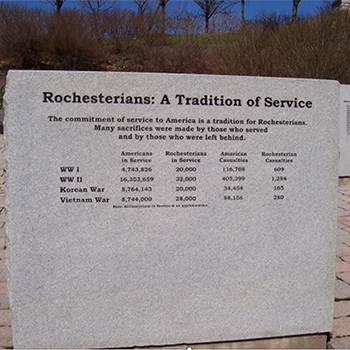
Rochester: A Tradition of Service
Rochester: A Tradition of Service – The commitment of service to America is a tradition for Rochesterians. Many sacrifices were made by those who served and by those who were left behind. More people were killed in Vietnam from the Greater Rochester area than were killed from the states of Delaware, Hawaii, Idaho, Montana, Nevada, New Hampshire, North Dakota, Rhode Island, South Dakota, Vermont, Wyoming, and the District of Columbia.
More than 4,000 New York State residents were killed, second only to the more than 5,500 killed from the state of California. Eight men from the nearby small town of Holley, New York were killed in Vietnam, the highest number of KIAs per capita of any town in the USA. God Bless each and every person who made the ultimate sacrifice.
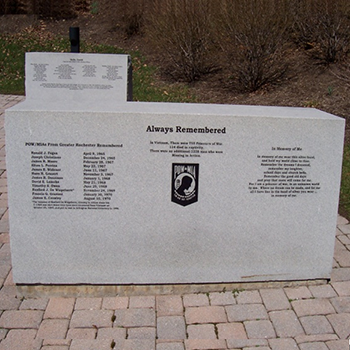
Always Remembered: (Side 1)
In Vietnam there were 755 Prisoners of War. 114 died in captivity. There were an additional 2,338 men who were Missing in Action.
POW/MIAs From Greater Rochester Remembered:
Ronald J. Fegan – April 9, 1965
Joseph Christiano – December 24, 1965
James R. Moore – February 28, 1967
Elton L. Perrine – May 22, 1967
James E. Widener – June 11, 1967
Hans H. Grauert – November 3, 1967
James R. Dennison – January 1, 1968
David E. Lemcke – May 21, 1968
Timothy S. Owen – June 29, 1968
Rexford J. De Wispelaere – November 24, 1969
Francis G. Graziosi – January 10, 1970
John E. Crowley – August 10, 1970
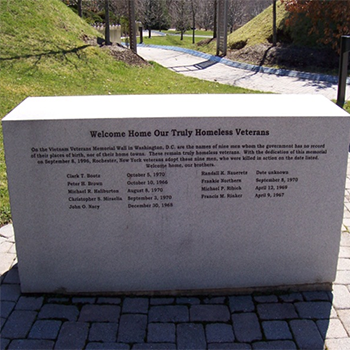
Welcome Home Our Truly Homeless Veterans: (Side 2)
On the Vietnam Veterans Memorial Wall in Washington, D.C. are the names of nine men whom the government at the time of the dedication in 1982 had no record of their places of birth, nor of their hometowns. These were truly homeless veterans. With the dedication of this Memorial on September 8, 1996, Rochester, New York veterans adopted these nine men, who were killed in action on the date listed. Welcome home, our brothers.
However, since the time of the dedication of the Vietnam Veterans Memorial of Greater Rochester some of this information has changed. 3 are alive & 3 have paperwork found.
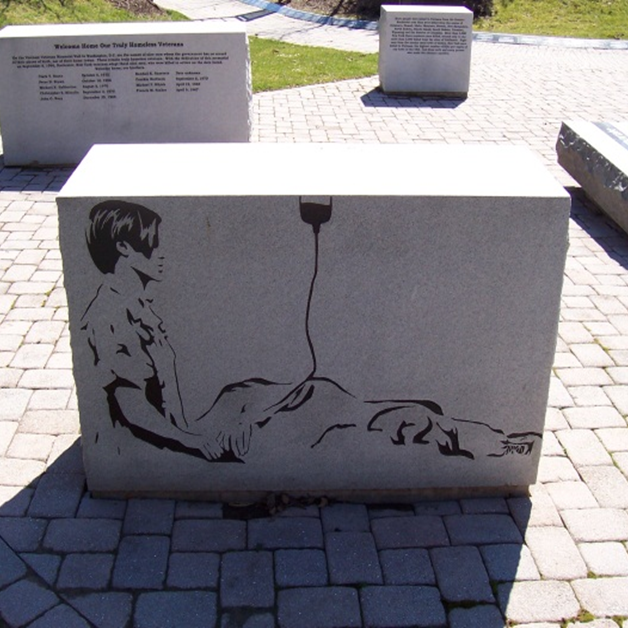
Women In War
We dedicate this passage to our sisters who served in Vietnam. They served their country and us very well, saving many lives. They provided great comfort to those who were wounded and to those for whom that woman was the last face he ever saw.
There were 7,484 women (6,250 or 83.5% were nurses) who served in Vietnam. Eight American nurses died in Vietnam; one was killed in action. A ninth nurse from the Australian Nurse Corps also died in Vietnam.
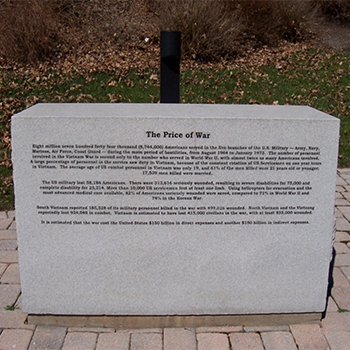
The Price of War: (Side 1)
Eight million seven hundred forty-four thousand (8,744,000) Americans served in the five branches of the U.S. Military – Army, Navy, Marines, Air Force, Coast Guard – during the main period of hostilities, from August 1964 to January 1973. The number of personnel involved in the Vietnam War is second only to the number who served in World War II, with almost twice as many Americans involved. A large percentage of personnel in the service saw duty in Vietnam, because of the constant rotation of US Servicemen on one year tours in Vietnam. The average age of US combat personnel in Vietnam was only 19, and 61% of the men killed were 21 years old or younger, 17,539 men killed were married.
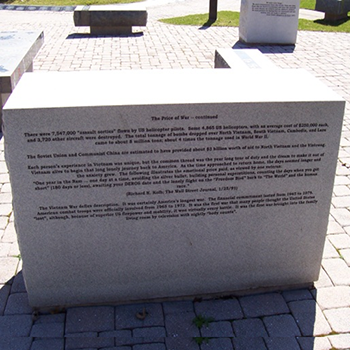
The Price of War: (Side 2)
The US military lost 58,184 Americans. There were 313,616 seriously wounded, resulting in severe disabilities for 73,000 and complete disability for 23,214. More than 10,000 servicemen lost at least one limb. Using helicopters for evacuation and the most advanced medical care available, 82% of Americans seriously wounded were saved, compared to 71% in World War II and 74% in the Korean War.
It is estimated that the war cost the United States $150 billion in direct expenses and another $150 billion in indirect expenses.
American combat troops were officially involved from 1965 to 1973. It was the first war that many people thought the United States “lost”, although, because of superior US firepower and mobility, it won virtually every battle. It was the first war brought into the family living rooms by television with nightly “body counts”.
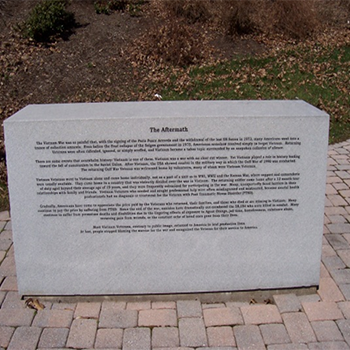
The Aftermath: (Side 1)
Returning Veterans were often ridiculed, ignored, or simply scoffed, and Vietnam became a taboo topic surrounded by an unspoken collection of silence.
Vietnam was a war with no clear-cut winner.
Vietnam Veterans went to Vietnam alone and came home individually, not as a part of a unit as in WWI, WWII and the Korean War, where support and camaraderie were usually available. They came home to a country that was violently divided over the war in Vietnam.
Most Vietnam Veterans, contrary to public image, returned to America to lead productive lives.
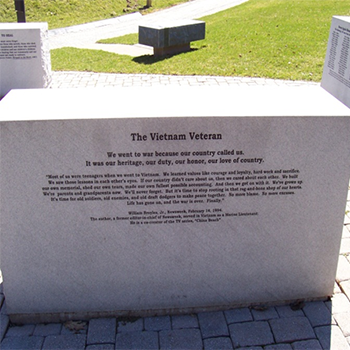
The Vietnam Veteran
We went to war because our country called us. It was our heritage, our duty, our honor, our love of country. “Most of us were teenagers when we went to Vietnam. We learned values like courage and loyalty, hard work and sacrifice. We saw those lessons in each other’s eyes. If our country didn’t care about us, then we cared about each other. We built our own memorial, shed our own tears, made our own fullest possible accounting. And then we got with it. We’ve grown up. We’re parents and grandparents now. We’ll never forget. But it’s time to stop rooting in that rag and bone shop of our hearts. It’s time for old soldiers, old enemies, and old draft dodgers to make peace together. No more blame. No more excuses. Life has gone on, and the war is over. Finally.”
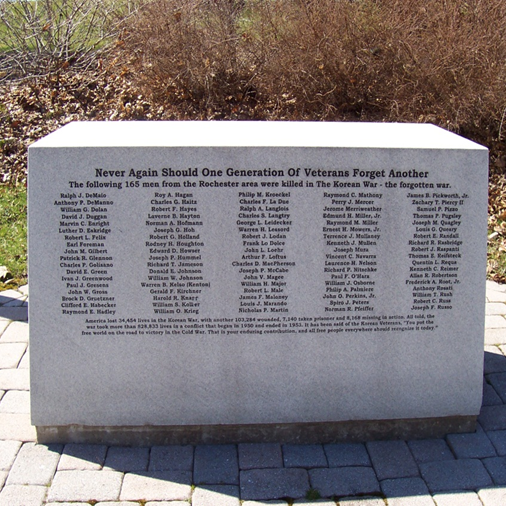
Never Again Shall One Generation of Veterans Forget Another
America lost 34,454 lives in the Korean war, with another 103,284 wounded. 7,140 taken prisoner and 8,168 reported missing in action. All told, the war took more than 828,833 lives in a conflict that began in 1950 and ended in 1953. It has been said of the Korean Vets, “You put the free world on the road to victory in the Cold War. That is your enduring contribution, and all free people everywhere should recognize it today.” The following are 165 men from the Rochester area killed in The Forgotten War: Korea.
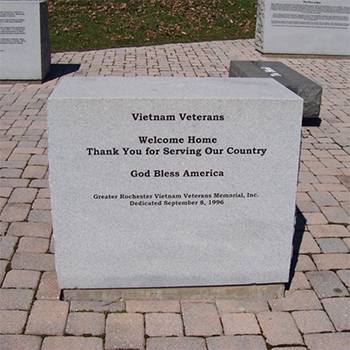
Vietnam Veteran: (Side 1)
Welcome home, Thank You
Memorial Dedication Date
September 8, 1996
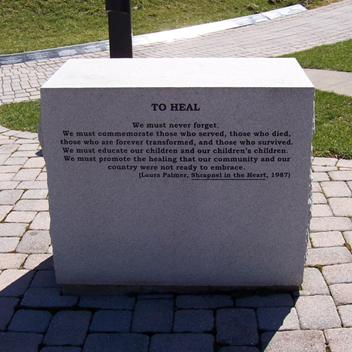
To Heal: (Side 2)
We must never forget.
We must commemorate those who served, those who died, those who are forever transformed, and those who survived.
We must educate our children and our children’s children.
We must promote the healing that our community and country were not ready to embrace.
Laura Palmer, Shrapnel in the Heart, 1987
Related Sites:
